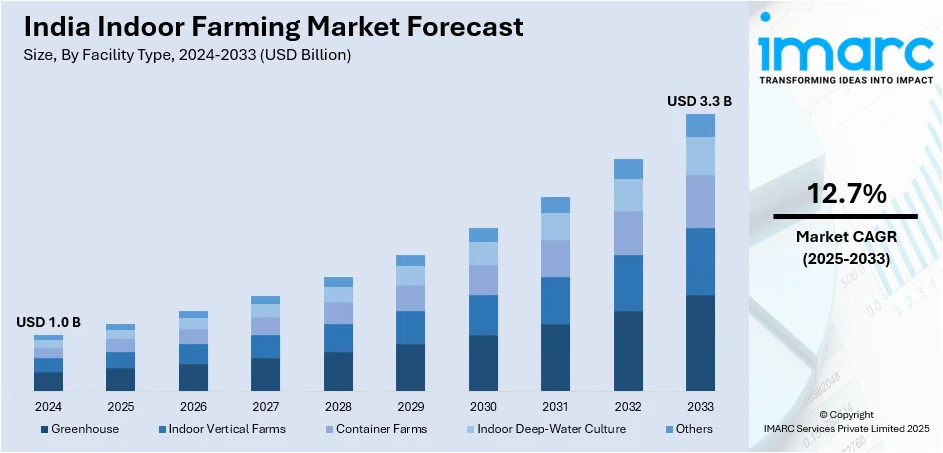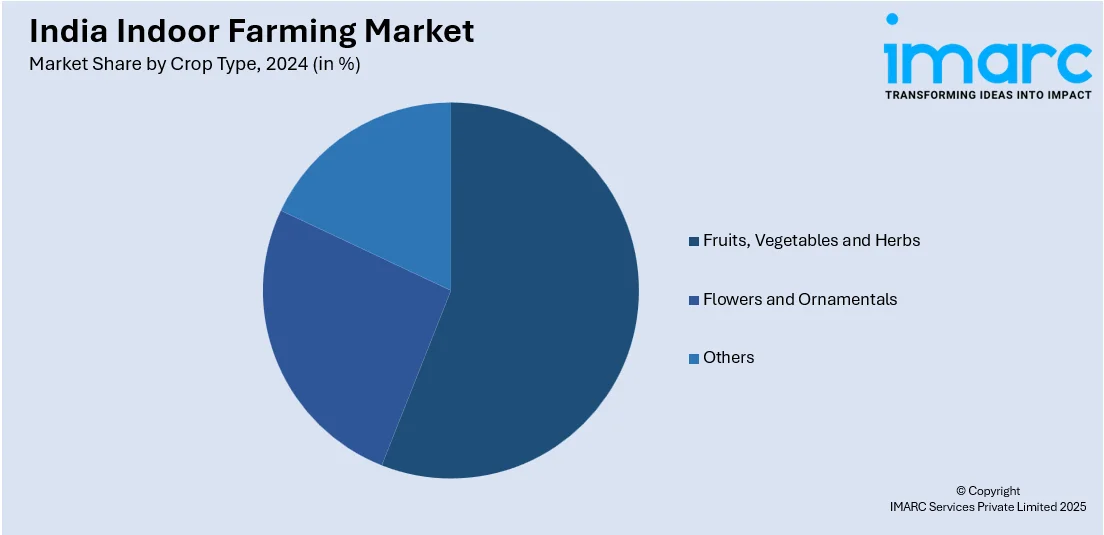
India Indoor Farming Market Size, Share, Trends and Forecast by Facility Type, Crop Type, Component, Growing System, and Region, 2025-2033
Market Overview:
The India indoor farming market size reached USD 1.0 Billion in 2024. Looking forward, IMARC Group expects the market to reach USD 3.3 Billion by 2033, exhibiting a growth rate (CAGR) of 12.7% during 2025-2033. The surging focus on sustainable farming practices and water efficiency, the rising need for year-round crop availability, the scarcity of arable land, the increasing demand for organic produce, significant technological advancements, and supportive governmental initiatives represent some of the key factors driving the market.
|
Report Attribute
|
Key Statistics
|
|---|---|
|
Base Year
|
2024 |
|
Forecast Years
|
2025-2033
|
|
Historical Years
|
2019-2024
|
| Market Size in 2024 | USD 1.0 Billion |
| Market Forecast in 2033 | USD 3.3 Billion |
| Market Growth Rate (2025-2033) | 12.7% |
Indoor farming, also called controlled environment agriculture (CEA), is a modern farming practice where plants are grown within indoor facilities, such as warehouses or containers, under highly controlled conditions. This practice uses advanced technology, including artificial lighting, such as LEDs, temperature regulation, and hydroponics or aeroponics, to grow crops. The main advantage of indoor farming is that it enables year-round crop production, regardless of outdoor weather conditions. It also allows for significant water savings, up to 90-95% less than traditional agriculture, due to its efficient recirculation systems. Indoor farms can be located in urban areas, reducing food miles and enhancing fresh produce availability in food deserts. Besides this, it helps increase crop yields per unit area, overcoming limitations of traditional farming such as land scarcity, climate unpredictability, and pesticide use. As research advances and technologies improve, indoor farming could become an increasingly viable solution to global food security challenges. With the combination of technology and agriculture, indoor farming offers a sustainable and scalable method of feeding the ever-growing global population.

To get more information on this market, Request Sample
India Indoor Farming Market Trends:
The escalating trend of indoor farming in India is primarily driven by the increasing need for sustainable methods to meet the growing demand for food due to the country's rapidly expanding population. In line with this, the expanding deployment of advanced technologies, such as hydroponics and aeroponics, for indoor cultivation of crops offers a unique opportunity to significantly reduce water usage and grow crops year-round, irrespective of the external climatic conditions. This, in turn, has fueled the adoption of indoor farming methods in the country. Moreover, the surging need to improve crop yield and quality in the agricultural sector is propelling the transition from traditional farming practices to controlled environment agriculture, strengthening the market growth. Concurrent with this, bolstering industrial growth is further influencing the demand for indoor farming in the country, as the need for space optimization in urbanized areas encourages vertical farming techniques, leading to efficient land use. In addition to this, the escalating awareness of the adverse impacts of agrochemicals on health and the environment is fueling the demand for organically grown produce, creating a favorable outlook for market growth. Furthermore, the advent of eco-friendly indoor farming methods, coupled with government support in promoting sustainable agriculture practices, is presenting remunerative growth opportunities for the market.
India Indoor Farming Market Segmentation:
IMARC Group provides an analysis of the key trends in each segment of the India indoor farming market report, along with forecasts at the country level for 2025-2033. Our report has categorized the market based on facility type, crop type, component, and growing system.
Facility Type Insights:
- Greenhouse
- Indoor Vertical Farms
- Container Farms
- Indoor Deep-Water Culture
- Others
The report has provided a detailed breakup and analysis of the market based on the facility type. This includes greenhouse, indoor vertical farms, container farms, indoor deep-water culture, and others.
Crop Type Insights:

- Fruits, Vegetables and Herbs
- Lettuce
- Spinach
- Kale
- Tomato
- Herbs
- Bell and Chili Peppers
- Strawberry
- Cucumber
- Others
- Flowers and Ornamentals
- Annuals
- Perennials
- Ornamentals
- Others
- Others
A detailed breakup and analysis of the market based on the crop type has also been provided in the report. This includes fruits, vegetables and herbs (lettuce, spinach, kale, tomato, herbs, bell and chili peppers, strawberry, cucumber, and others), flowers and ornamentals (annuals, perennials, ornamentals, and others), and others.
Component Insights:
- Hardware
- Structure
- LED Lights
- HVAC
- Climate Control System
- Irrigation Systems
- Others
- Software
- Web-based
- Cloud-based
The report has provided a detailed breakup and analysis of the market based on the components. This includes hardware (structure, LED lights, HVAC, climate control system, irrigation systems, and others) and software (web-based and cloud-based).
Growing System Insights:
- Aeroponics
- Hydroponics
- Aquaponics
- Soil-based
- Hybrid
A detailed breakup and analysis of the market based on the growing system has also been provided in the report. This includes aeroponics, hydroponics, aquaponics, soil-based, and hybrid.
Regional Insights:
- South India
- North India
- West and Central India
- East India
The report has also provided a comprehensive analysis of all the major regional markets, which include South India, North India, West and Central India, and East India.
Competitive Landscape:
The report has also provided a comprehensive analysis of the competitive landscape in the market. Competitive analysis such as market structure, key player positioning, top winning strategies, competitive dashboard, and company evaluation quadrant has been covered in the report. Also, detailed profiles of all major companies have been provided.
India Indoor Farming Market Report Coverage:
| Report Features | Details |
|---|---|
| Base Year of the Analysis | 2024 |
| Historical Period | 2019-2024 |
| Forecast Period | 2025-2033 |
| Units | Billion USD |
| Scope of the Report | Exploration of Historical and Forecast Trends, Industry Catalysts and Challenges, Segment-Wise Historical and Predictive Market Assessment:
|
| Facility Types Covered | Greenhouse, Indoor Vertical Farms, Container Farms, Indoor Deep-Water Culture, Others |
| Crop Types Covered |
|
| Components Covered |
|
| Growing Systems Covered | Aeroponics, Hydroponics, Aquaponics, Soil-based, Hybrid |
| Regions Covered | South India, North India, West and Central India, East India |
| Customization Scope | 10% Free Customization |
| Post-Sale Analyst Support | 10-12 Weeks |
| Delivery Format | PDF and Excel through Email (We can also provide the editable version of the report in PPT/Word format on special request) |
Key Benefits for Stakeholders:
- IMARC’s report offers a comprehensive quantitative analysis of various market segments, historical and current market trends, market forecasts, and dynamics of the India indoor farming market from 2019-2033.
- The research study provides the latest information on the market drivers, challenges, and opportunities in the India indoor farming market.
- Porter's five forces analysis assist stakeholders in assessing the impact of new entrants, competitive rivalry, supplier power, buyer power, and the threat of substitution. It helps stakeholders to analyze the level of competition within the India indoor farming industry and its attractiveness.
- Competitive landscape allows stakeholders to understand their competitive environment and provides an insight into the current positions of key players in the market.
Key Questions Answered in This Report
The India indoor farming market was valued at USD 1.0 Billion in 2024.
The India indoor farming market is projected to exhibit a CAGR of 12.7% during 2025-2033, reaching a value of USD 3.3 Billion by 2033.
The India indoor farming market is driven by rapid urbanization and declining arable land, pushing production into cities for fresher, locally grown produce. Rising consumer demand for pesticide-free, high-quality vegetables complements advances in tech like hydroponics, aeroponics, IoT, and AI. Government incentives and subsidies further accelerate adoption.
Need more help?
- Speak to our experienced analysts for insights on the current market scenarios.
- Include additional segments and countries to customize the report as per your requirement.
- Gain an unparalleled competitive advantage in your domain by understanding how to utilize the report and positively impacting your operations and revenue.
- For further assistance, please connect with our analysts.
 Request Customization
Request Customization
 Speak to an Analyst
Speak to an Analyst
 Request Brochure
Request Brochure
 Inquire Before Buying
Inquire Before Buying




.webp)




.webp)












